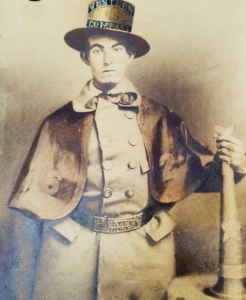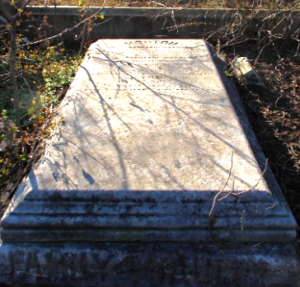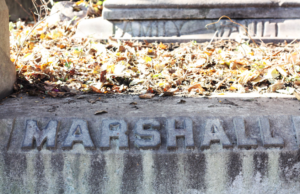Title: Army private, Civil War; volunteer firefighter, constable
Birthdate: August 3, 1835
Death Date: February 10, 1914
Plot Location: Section 7, Lot 24

Bill’s mother was about 17 when she married Thomas Marshall on April 22, 1935. She gave birth to Bill a little more than three months later. Thomas was a cooper, a person who makes barrels, and they had one other son, also named Thomas.
Thomas and Eliza reported on census records that they were born in Ireland. Those are probably more accurate than their death records, which relied on information from their descendants who thought they were both born in Pennsylvania.
Fighting Fires
In the 1860 census Bill was a brick maker but he was also a volunteer firefighter. Prior to 1871 when the city created a consolidated fire department with paid workers, neighborhoods had their own “hose companies” that responded to fires. In the first half of the 1800s they often wore felt stovepipe hats painted to identify their company.
That’s what Bill did in the photo above which was dated 1857, according to his descendants. The hats did get worn at fires but they were more commonly used as parade hats. The  more ornate they were, the better they could distinguish themselves from other companies. The hat pictured here was made in 1836 when Bill’s outfit, the Western Hose Company, was established on the south side of Filbert Street, west of 10th.
more ornate they were, the better they could distinguish themselves from other companies. The hat pictured here was made in 1836 when Bill’s outfit, the Western Hose Company, was established on the south side of Filbert Street, west of 10th.
Photography was the latest technological innovation, so for Bill to pay the high cost of a photograph in 1857 meant he must have really enjoyed his volunteer work. Even more enjoyable, for sure, was his romance with Catherine Brantis, whom he married at West York Street Methodist Episcopal Church in 1859.
They had the first of eight children, their only daughter, the following year. He gave up his job and his firefighting in the spring of 1861 when both he and his brother enlisted in the Pennsylvania Infantry.
Fighting Confederates
Those enlistments were only for three months because the rebellion in the South wasn’t expected to last that long. When their term was up, however, the Marshall boys chose not to reenlist. Bill probably resumed his volunteer work, at least for one year. He changed his mind and answered his country’s call once more in August of 1862, when he joined the 119th Pennsylvania Infantry. He was recruited by Colonel Peter C. Ellmaker, who commanded the regiment. He is also buried at Mount Moriah and his Notable life story can be found here.
Pvt. Marshall remained with the regiment until the war was over. That means he participated in battles at Fredericksburg, Chancellorsville, Gettysburg, Spotsylvania, the final assault on Petersburg, and the chase to Appomattox.
Once war was behind him, Bill and Catherine grew their family, as sons were born in 1866, 1867, 1868, 1869, 1872, 1874, and 1878.  The last one, Morton, lived only two years, and was the first in the family to be buried here. This horizontal “ledger” gravestone remembers him, his sister, Bill and Catherine, and Bill’s mother, Eliza. The plot has the family name in front and is bordered with a “coping” wall.
The last one, Morton, lived only two years, and was the first in the family to be buried here. This horizontal “ledger” gravestone remembers him, his sister, Bill and Catherine, and Bill’s mother, Eliza. The plot has the family name in front and is bordered with a “coping” wall.
Fighting Criminals
Bill found work in 1866 as a clerk, then as a driver, in a variety store, then in a liquor store. It was in 1877 that he settled on a career as a constable that lasted the rest of his life. The Marshalls remained for most of the next 30 years at 1932 Lombard Street.
Today, Philadelphia is the only municipality in the state that does not have a constable. It’s been speculated that the reason was because there had been so much corruption associated with the office. In Pennsylvania, a constable is elected in each borough, township, and city ward for a six-year term.
Once trained and certified, they perform judicial duties like serving summonses and arrest warrants, providing courthouse security, and keeping order at election polls. They also have the power to make arrests. The position has had its share of controversy and recent attempts at reform.
The 1908 city directory showed Bill was still holding that same office, but Catherine died that year so he moved in with his son Walter’s family. It may have been more than just coincidence that Walter’s occupation was a firefighter with the Philadelphia Fire Department, the same career chosen by another son, Harry.
 A stroke took Bill’s life in early 1914. Less than two months later, his brother died of heart disease. Thomas was buried at Mount Moriah in the Circle of St. John, as was his wife and three children.
A stroke took Bill’s life in early 1914. Less than two months later, his brother died of heart disease. Thomas was buried at Mount Moriah in the Circle of St. John, as was his wife and three children.


Support the Friends of Mount Moriah
Help us in our mission to restore and maintain the beautiful Mount Moriah Cemetery by donating to our cause or volunteering at one of our clean-up events.

